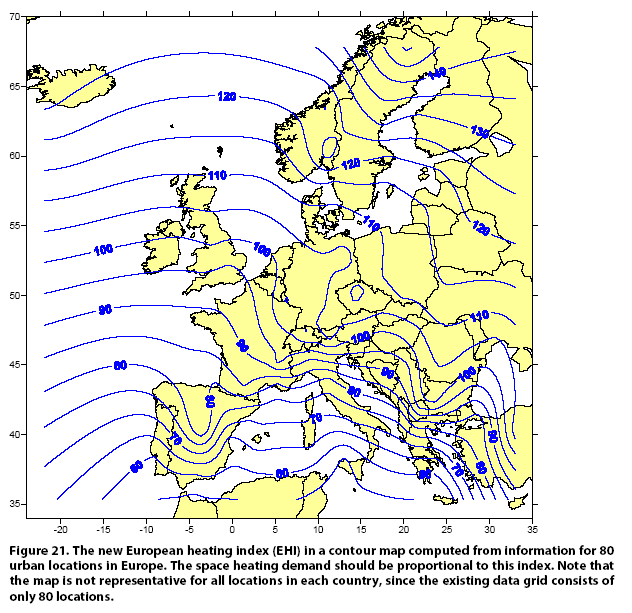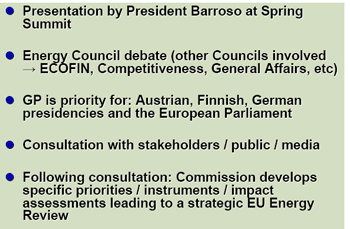Säger en rapport från Brittiska underhuset ‘Keeping the lights on’ (sammanfattning nedan) om framtidens energiförsörjning , men en del av den svenska diskussionen känns som ekon från det förflutna snarare än möjligheter för framtiden. När det gäller trygghet är frågan om hur många ägg man skall ha i korgen viktig. Dels för att vara mindre beroende av enstaka teknologier och leverantörer, och dels eftersom den värld vi lever i inte är samma som förr. Terrorismen är en ny komponent. Rapporten i Storbritannien har därför tittat på säkerhet och storskalig försörjning.
I Sverige skulle ytterligare satsning på kärnkraft när vi redan har drygt 50% i el-balansen inte öka tryggheten. Diversifiering är svårt men nödvändigt och det finns ingen “silver bullet”. Worldwatch Institutes tidning (May/June 2006) gör en genomgång av kärnkraftens möjligheter och tidigare “kraftsamlingar” i artikeln “Brave Nuclear World”. Inte heller då var kärnkraft någon “silver bullet”.
————————————————————————————————
Ur Brittiska underhusets rapport:
Executive Summary
1. By 2016, it is likely that between 15 and 20GW of electricity generating plant will be decommissioned. This amounts to nearly a quarter of total UK generating capacity. Over the next 9 years, therefore, very substantial investment in new generating capacity and energy efficiency will be required if the lights are to stay on?even in the absence of demand growth. Further substantial investment on a comparable scale may be required in the following decade.
2. At the same time, the UK is facing the unprecedented challenge of achieving radical reductions in carbon emissions in an effort to combat global warming?as reflected in the difficulty of achieving the UK 2010 carbon reduction target. The electricity generating sector accounts for nearly a third of total emissions and it will therefore need to play a significant role in achieving such reductions, and indeed the achievement of the 2050 target will depend heavily on the nature of investment in generating capacity over the next two decades. The Energy White Paper of 2003 addressed the need for carbon reductions across the economy but did not set specific targets for the generating sector. However, it endorsed the view set out in the Performance and Innovation Unit (PIU) report that new gas-fired plant, renewables and energy efficiency could make up for the potential generating gap.
3. Over the next ten years, nuclear power cannot contribute either to the need for more generating capacity or to carbon reductions as it simply could not be built in time. The potential generating gap during this period will need to be filled?largely by an extensive programme of new gas-fired power stations, supplemented by a significant growth in renewables. Contrary to popular belief, a further ‘dash for gas’ would result in significant carbon savings. Moreover, it is not clear how much effect the replacement of older coal and nuclear plant by gas will have on the security of total electricity supplies, as we will in any case become highly dependent on foreign imports of fossil fuels for our total energy requirements?including over twice as much natural gas for industrial and domestic uses as we use for electricity generation.
4. By 2016 at the latest, substantial further investment in generating capacity will be needed, and there are a number of different lower-carbon technologies which could contribute on a large scale?including renewables, microgeneration, offshore wind, nuclear, and carbon capture and storage. But there is substantial evidence to show that progress in deploying key technologies?in particular carbon capture and storage, off-shore wind, and microgeneration?is inadequate. The real issue which the Government is failing to address is whether the policy and regulatory framework in place is sufficient to stimulate the growth of lower-carbon generation on the scale required.
5. All lower-carbon generating technologies are more expensive than coal and gas, and will require a long-term funding framework in order to reduce investment risk and ensure that the necessary investment takes place. The current highly liberalised UK electricity market structure is too short term and fails to provide such a framework. Indeed, it is not clear whether it will even ensure that enough investment takes place to keep the lights on by 2016. There are a number of options open to the Government to address this?including the introduction of some form of capacity payment, the development of low-carbon generation contracts, and the modification of the Renewables Obligation to provide a range of incentives for different technologies. The Government will need to consider what changes to the market structure are required as part of the Energy Review.
6. Nuclear power raises a variety of issues which would need to be satisfactorily resolved before any decision to go ahead is taken. These include long-term waste disposal, public acceptability, the availability of uranium, and the carbon emissions associated with nuclear. There are also serious concerns relating to safety, the threat of terrorism, and the proliferation of nuclear power across the world. Moreover, given the fact that substantial changes in the relative cost of energy technologies are likely to occur over the next 20 to 30 years, it is by no means clear whether investors will wish to commit themselves to 70 years of nuclear generation. There are striking similarities here to the position in 1980 when a similar large scale programme of nuclear new build eventually resulted in the construction of only one new reactor?Sizewell B.
7. A Government decision to support a major programme of nuclear new build must also take account of the impacts on investment in other areas?notably energy efficiency, renewables, carbon capture and storage, and the development of distributed generation systems. The potential of these various technologies over the next 20 to 30 years is immense, and any public subsidies for nuclear must be weighed against the substantial progress towards reducing carbon emissions and ensuring a greater degree of security of supply which these alternatives could achieve with similar subsidies. However, as all forms of lower-carbon generation will require financial support, the Government should accept that the shift to a sustainable energy strategy cannot be based?at least in the medium term?on maintaining low energy prices.
8. The Government should be doing far more to promote progress in these other areas. Carbon capture and storage will, in particular, be of crucial importance in view of forecasts which show increasing use over the next thirty years of fossil fuels?especially in developing countries such as China and India. Renewables and distributed generation could also contribute hugely in both a national and global context?but many of the technologies involved warrant special support to bring them to market and achieve the cost-reductions which will make them competitive.
9. While this inquiry has focussed primarily on supply side issues, we cannot emphasise enough that reducing demand is also a vital component on the path to a sustainable energy strategy. There is, as yet, little evidence to suggest that the Government has succeeded in doubling the rate of energy efficiency improvements as envisaged in the Energy White Paper. Far more decisive action and political leadership is required, and we would also urge the Government to consider setting absolute targets for reductions in demand as a way of stimulating the growth of energy efficiency and guaranteeing the level of carbon savings achieved.
10. The nature of the current Energy Review is unclear?whether it is specifically fulfilling the Prime Minister’s desire to make a decision on nuclear, whether it is a review of electricity generating policy, whether it is a wider review of progress against the Energy White Paper, or whether it is reopening the broad policy debate which the White Paper itself encompassed. We are also concerned that it does not appear to have resulted from a due process of monitoring and accountability, and that the process by which it is being conducted appears far less structured and transparent than the process by which the White Paper itself was reached.
11. If the Energy Review is focussed mainly on electricity generation and, in particular, a decision on nuclear, then it is unclear what the nature of such a decision could be and the Secretary of State himself was unable to explain this. Indeed, the Government has always argued that its role is not to prescribe the fuel mix, and it has invested much effort in developing a fully liberalised market which will determine for itself such investment decisions. The frequent statements that it must make a decision on energy, and specifically on nuclear, fundamentally conflict with such an approach and would therefore represent a major U-turn in energy policy. Moreover, if the Government does indeed come to a decision on nuclear, it is unclear why it should not also come to a decision on off-shore wind, marine, or micro-CHP - let alone the array of possible measures to support energy efficiency. Yet we never hear Government ministers talking in such terms.
12. If, on the other hand, the Energy Review is a wider ranging review of policy it will fail to command the support of stakeholders, the public and politicians if what emerges is significantly different from the course that was charted in the Energy White Paper without a proper explanation of how circumstances have altered sufficiently to justify such a change and without further wide-ranging consultation on the nature of the change. It is also unsatisfactory that it was launched before the publication of the long-delayed Climate Change Programme Review and will be concluded before the Stern Review has reported. This does not inspire confidence about the extent of coordination within and between different parts of Government.
13. We remain convinced that the vision contained in the White Paper?with its focus on energy efficiency and renewables as cornerstones of a future sustainable energy policy - remains correct. What is now needed is a far greater degree of commitment from the Government in implementing it. Alongside, more attention needs to be given to technologies such as clean coal and carbon capture and storage, both of which may have a significant role to play nationally and globally.
Skrivet av Hans Nilsson tidpunkt: 05:25 AM. Sorterat under:
(0) Kommentarer • Permalink









